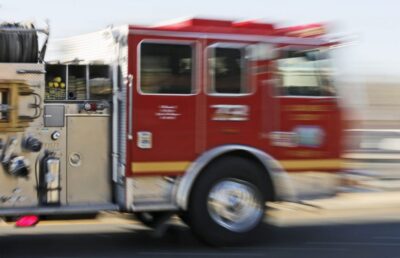During the recent “A Conversation with the Sheriff” event, Santa Clarita Valley Sheriff’s Station Capt. Justin Diez sought to raise awareness and support for not just station staff, but also a group of dedicated volunteers who save lives on a regular basis: the SCV Search and Rescue Team.
The group of unpaid “high-risk civilian volunteers” bravely rappel up and down steep ravines, scale peaks and then, when necessary, haul stranded hikers or drivers back down those climbs.
The Search and Rescue Team had its busiest year ever in 2023, responding to almost 90 callouts last year, according to Justin Miyahira, a member of the SRT and head of public safety at Six Flags Magic Mountain, who attended the event hosted by the SCV Sheriff’s Foundation.
Diez was seeking support because the team’s numbers have decreased while the demand for service has only gone up, he said.

While the pandemic resulted in the lowest crime rate in modern recorded history while everything was shut down, Diez said, unique challenges sprung up in their place.
In addition to not being able to have volunteers around due to COVID restrictions at the time, during the pandemic, lots of people became hiking enthusiasts, an activity that comes with inherent risk.
SRT incidents can involve a range of activities including stranded hikers, others trapped in weather-related emergencies like floods or when a vehicle goes off-road and down a ravine.
“Most people don’t realize that No. 1, we’re all volunteers; but No. 2, that it’s a nonfunded portion that we are required to maintain — in the law, we are required to maintain a search and rescue team, but there’s absolutely no funding for it,” Miyahira said.
The team, which had 15 members recently, is on call 24 hours a day, seven days a week in case of emergency, or whenever the team is needed.
“Being a part of the (Mountain Rescue Association), we could be called from any other team in California,” said Tony Buttitta, the team’s captain, during a March interview after the team qualified for its MRA certification at Convict Lake. “Last weekend or the weekend before, we got called up to Mount Baldy, in the middle of a high wind and snow — helicopters couldn’t get in, so they put out a countywide callout — that one was to help the San Bernardino (Sheriff’s Department) team.”
Some might have seen SRT members helping at weekend festivals, such as Boots in the Park or Tequila and Tacos — but they’re not there to enjoy the brews or the tunes.
The team members must first qualify as a certified emergency medical technician, so they can help if someone needs immediate assistance.
The preparation involved in joining the team also makes the SRT’s unfunded mandate a considerable one.
Once a prospective volunteer earns their EMT certification, and passes a thorough background check, a person is eligible to become a probationary member, Miyahira said.


“Once you pass that, you attend meetings, and a few trainings,” he said, “and really, we want to see your commitment level.”
Then there is technical rope training — a class and then team test, which includes tying various knots. And of course, learning how to use the hardware, like a Stokes basket, the patient stretcher used in rescues.
“And then once you pass the test, you are part of the team,” he added.
But wait, there’s more, as they say.
“Once you’re part of the team,” Miyahira said, “you then have to commit to a certain amount of hours at least per month at the very minimum to maintain (your spot) on the team.”
While there’s a significant commitment level, they’re also a very close-knit group, Buttitta said.
“We’re like a big family,” said Buttitta, who’s also a reserve deputy.
He’s made some of his best friends through his work with the Sheriff’s Department, he added. “We not only work together, but off-duty we hang out together, and our families do things together.”
Anyone interested in supporting or joining the Search and Rescue Team can contact Tony Buttitta at [email protected]. Anyone who would like to volunteer at the station, which involves a range of duties from clerical assistance to help performing vacation checks on vacant homes, can call Sgt. Bill Edson at the SCV Sheriff’s Station at 661-287-5732, or email [email protected].










